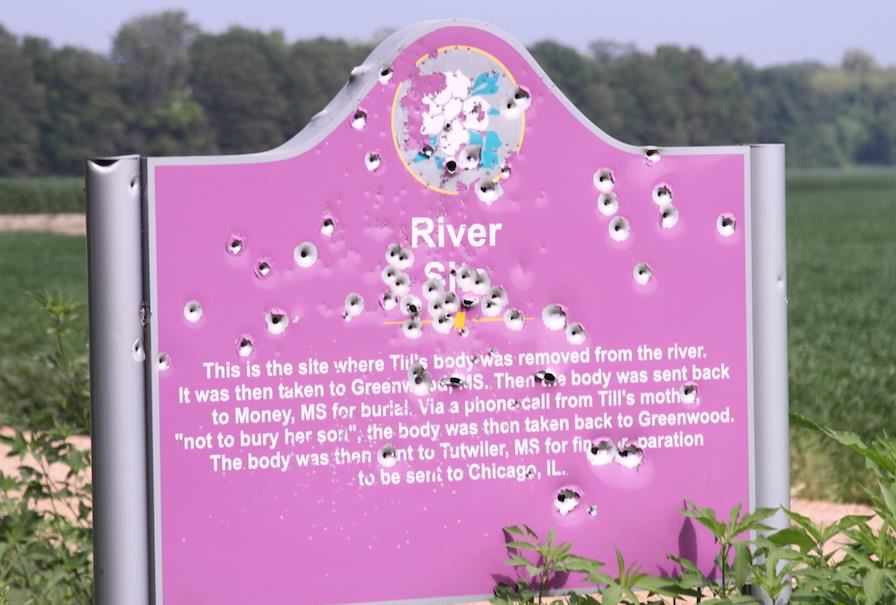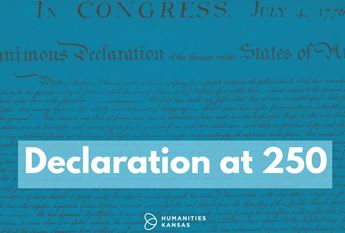

Till Marker Was Just 35 Days Unshot
August 10, 2018
By Dave Tell
Originally published in the Tallahatchie County Sun Sentinel
Thirty-five days after it was dedicated, a sign at Graball Landing marking the spot where Emmett Till's body was pulled from the Tallahatchie River was pierced with four gunshots. The gunshots on the night of July 21, 2018, was the latest in a 10-year saga of vandalism and thievery that has plagued local attempts to remember the 1955 murder of Emmett Till.
The sign was the Emmett Till Memorial Commission's third attempt to mark the site. The first sign was announced on Oct. 2, 2007. Members of the Till family had travelled from Chicago for the occasion and were gathered at the water's edge outside the village of Glendora, 100 miles south of Memphis, in the heart of the Mississippi Delta. The riverside marker at Graball Landing was the final site on the Civil Rights Driving Tour, an eight-site pilgrimmage intended by the commission to, among other things, symbolize the effort to forge a "new kind of bi-racial community." That, at least, was the vision of Betty Pearson, the 84-year-old scion of one of the Delta's oldest white families and a battle-tested veteran of the Mississippi freedom movement.
Indeed, from the perspective of the ETMC, the historical markers were never an end in themselves. It had taken the state of Mississippi 49 years to build a single memorial to the Till murder and this quietude, the ETMC believed, was symptomatic of a hesistation — if not an inability — to talk openly about race. Formed in 2005, the ETMC is a group of local citizens who, in the face of widespread apathy and inaction, banded together to pursue racial reconciliation. Their strategy? Do the practical work of remembrance: put up signs, build a museum and tell stories.
Pearson's enthusiasm for the commemorative marker at Graball Landing was not widely shared. Six months after the commission installed the sign, it disappeared. Tire tracks leading from the site to the riverbank led Sheriff William Brewer to conclude that the sign had been tossed into the Tallahatchie River, just as Till's body once had -- an irony not lost on the local black community. The commission quickly installed a second sign at Graball Landing, but by the spring of 2013, vandals had riddled it with bullet holes. For ETMC founder Jerome Little, the vandalism was evidence of ongoing racial tension.
In October 2016, the local debate over the meaning of the vandalized sign exploded on the national scene. New York University film student Kevin Wilson Jr. was in the Delta creating a short film on the Till murder when he found the Graball Landing sign filled with bullet holes. Unaware of the eight-year history of vandalism at the site, Wilson snapped a picture of the bullet-riddled sign and posted it to Facebook. Thousands of shares later, the entanglement of race and commemoration at Graball Landing was being covered by the New York Times, Washington Post, and a vast array of media outlets. Disseminated by powerful media, the image of the bullet-riddled sign generated intense moral outrage and a widespread demand to replace the sign. The commission quickly cut down the old sign to make room for the third one.
The third sign was dedicated on June 21, 2018. For 35 days, the sign was in pristine condition. There were no more chipped maganolia flowers, stolen finials, dented aluminum posts, or bullet holes. And then it was shot. Again.
Is a fourth sign needed? I think not, for three reasons.
First, the original mission of the ETMC was never simply to remember Till's murder. Their vision, rather, was to use commemorative work to "forge a new kind of bi-racial community." While an ever-new sign might accurately describe the events of 1955, it suggests, wrongly, that the past is entirely in the past, discreet and disconnected from the present. A bullet-pierced marker, by contrast, is the perfect icon for a community still rent by the memory of Till's murder. The bullet holes bear eloquent witness to the fact that work remains to be done, that the memory of Till's murder still cuts a rift through the heart of the modern day Delta.
The bullet holes bear eloquent witness to the fact that work remains to be done, that the memory of Till's murder still cuts a rift through the heart of the modern day Delta.
Second, the ETMC is now pursuing an electronic form of remembrance that can neither be stolen or shot. When funded, the Emmett Till Memory Project will use a GPS-enabled app to take visitors to 10 sites related to the murder of Emmett Till. Unlike a traditional memorial -- shot or whole -- the ETMP can tell multiple stories at once. At Graball Landing, for instance, the app will teach people what happened in 1955, and it will record how those long-past events reach our present moment. It will record the ongoing cycle of remembrance and vandalism at Graball Landing and, by doing so, it will comemmorate far more than the events of 1955. It will be a memorial to the lessons we have not yet learned from the distant murder.
Third, the cycles of vandalism and remembrance suggest that the ETMC may need help from the federal government. While local citizens have for 13 years raised money, told stories, and built a commemorative infrastructure unlike anything the Mississippi Delta has ever seen, they need help. If the political will were there, President Trump could order these sites to become a national monument, offering protection for the sites and a federal investment in racial reconciliation.
If Emmett Till was a martyr for the dearest ideals of our country, the least we can do is to ensure that the sites of his murder are henceforth used in the service of those ideals.
About Dave Tell
Dave Tell is a professor of Communication Studies at the University of Kansas who presents "The Murder of Emmett Till" as part of the HK Speakers Bureau. His book, "Remembering Emmett Till," will be published in the spring by The University of Chicago Press.



